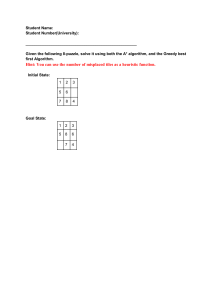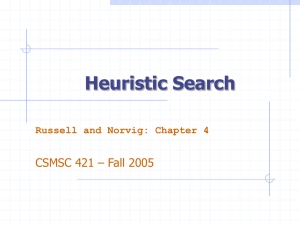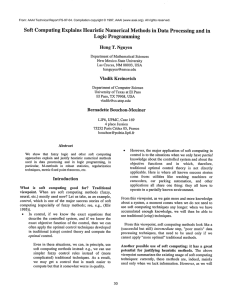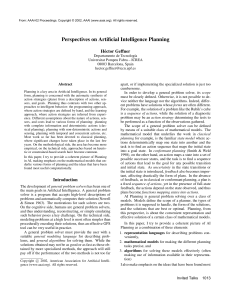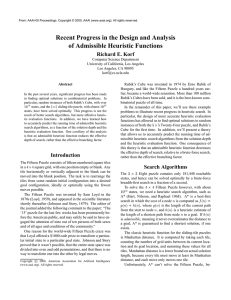Homework 2
advertisement
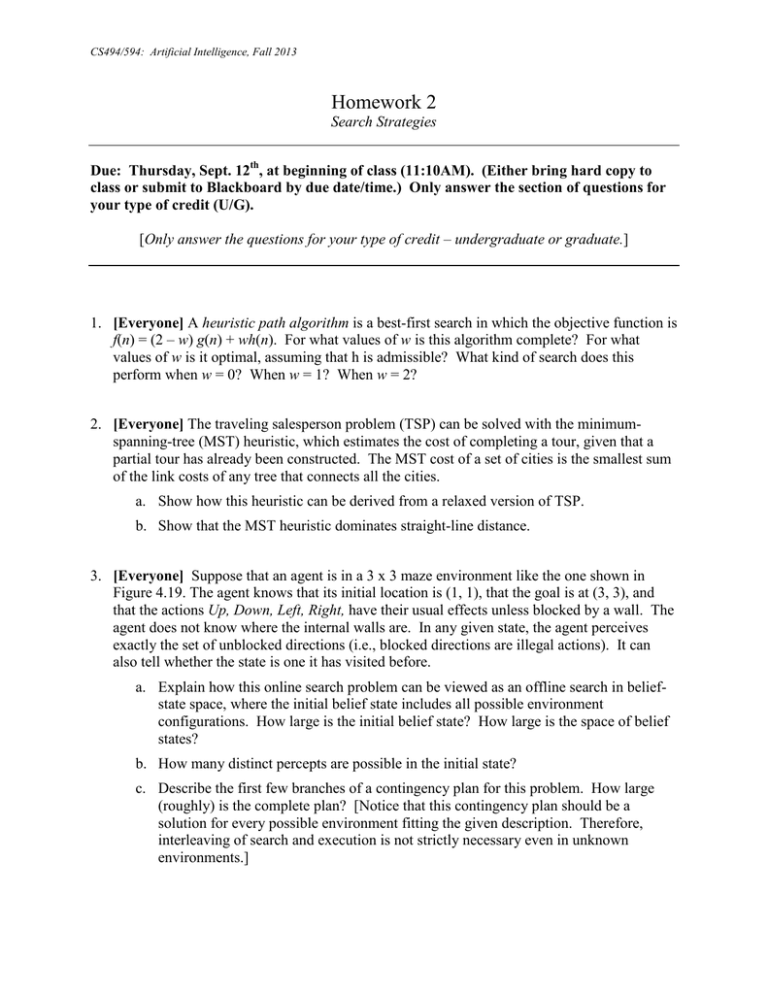
CS494/594: Artificial Intelligence, Fall 2013
Homework 2
Search Strategies
Due: Thursday, Sept. 12th, at beginning of class (11:10AM). (Either bring hard copy to
class or submit to Blackboard by due date/time.) Only answer the section of questions for
your type of credit (U/G).
[Only answer the questions for your type of credit – undergraduate or graduate.]
1. [Everyone] A heuristic path algorithm is a best-first search in which the objective function is
f(n) = (2 – w) g(n) + wh(n). For what values of w is this algorithm complete? For what
values of w is it optimal, assuming that h is admissible? What kind of search does this
perform when w = 0? When w = 1? When w = 2?
2. [Everyone] The traveling salesperson problem (TSP) can be solved with the minimumspanning-tree (MST) heuristic, which estimates the cost of completing a tour, given that a
partial tour has already been constructed. The MST cost of a set of cities is the smallest sum
of the link costs of any tree that connects all the cities.
a. Show how this heuristic can be derived from a relaxed version of TSP.
b. Show that the MST heuristic dominates straight-line distance.
3. [Everyone] Suppose that an agent is in a 3 x 3 maze environment like the one shown in
Figure 4.19. The agent knows that its initial location is (1, 1), that the goal is at (3, 3), and
that the actions Up, Down, Left, Right, have their usual effects unless blocked by a wall. The
agent does not know where the internal walls are. In any given state, the agent perceives
exactly the set of unblocked directions (i.e., blocked directions are illegal actions). It can
also tell whether the state is one it has visited before.
a. Explain how this online search problem can be viewed as an offline search in beliefstate space, where the initial belief state includes all possible environment
configurations. How large is the initial belief state? How large is the space of belief
states?
b. How many distinct percepts are possible in the initial state?
c. Describe the first few branches of a contingency plan for this problem. How large
(roughly) is the complete plan? [Notice that this contingency plan should be a
solution for every possible environment fitting the given description. Therefore,
interleaving of search and execution is not strictly necessary even in unknown
environments.]
CS494/594: Artificial Intelligence, Fall 2013
4. [Undergraduate students only] Consider the sensorless version of the erratic vacuum world.
Draw the belief-state space reachable from the initial belief state {1, 2, 3, 4, 5, 6, 7, 8}, and
explain why the problem is unsolvable.
5. [Graduate students only] We have seen two heuristics for the 8-puzzle: Manhattan distance
and misplaced tiles. Several heuristics in the literature purport to improve on this. Look up
the following two articles -- Mostow and Prieditis (1989) and Hannson, et al., (1992) – and
for each, summarize the heuristic that they are proposing. (See bibliography in text for
complete citation. These can be found using Google Scholar.)
6. [Graduate students only] On page 108 is the definition of the relaxation of the 8-puzzle, in
which a tile can move from square A to square B if B is blank. The exact solution of this
problem defines Gaschnig’s heuristic (Gaschnig, 1979). Explain why Gaschnig’s heuristic
is at least as accurate as h1 (misplaced tiles), and show cases where it is more accurate than
both h1 and h2 (Manhattan distance). Suggest a way to calculate Gaschnig’s heuristic
efficiently.
